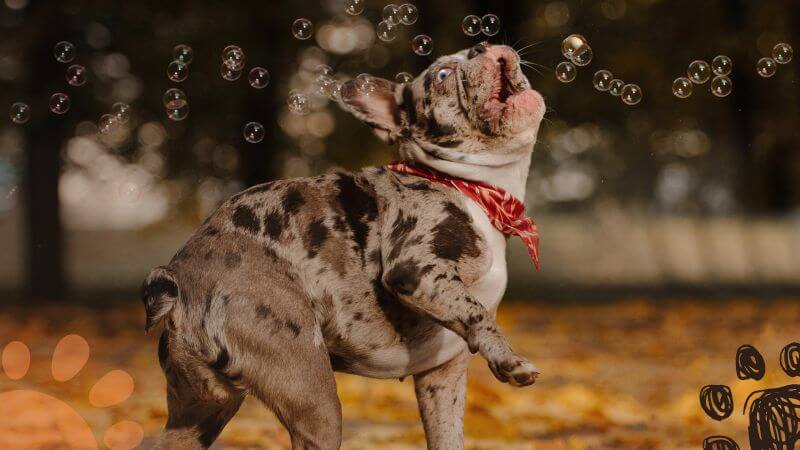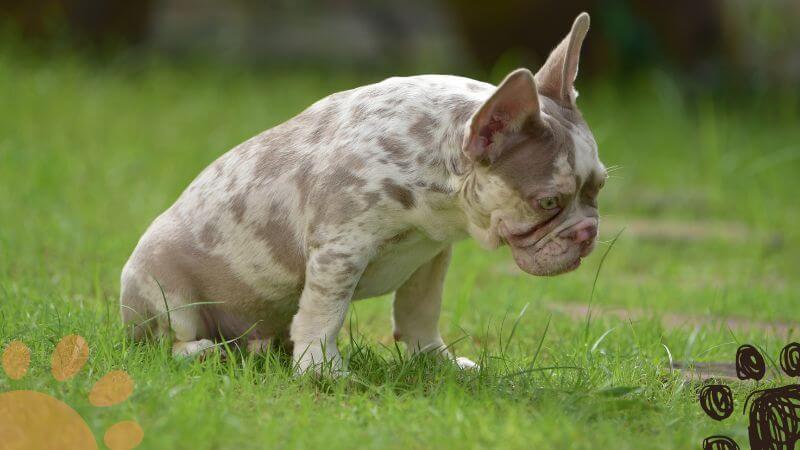French Bulldogs come in a wide variety of colors, including a set of colors called “merle.” Merle French Bulldogs are some of the rarest in the breed with a unique, patterned coat.
Like all Frenchies, the Merle French Bulldogs are adorable and much loved by people around the world.
In the guide below, you’ll learn everything you need to know about Merle French Bulldogs. You’ll learn about their appearance, temperament, special grooming, and medical needs.
While prices often fluctuate wildly based on availability and demand, we’ll also provide you with information about how much these adorable pups cost.
See also: Guide to French Bulldog Yorkie Mix (The Frorkie)

How Are Merle French Bulldogs Bred?
Selective breeding of French Bulldogs has allowed breeders to achieve the merle variation. However, Merle French Bulldogs are not purebred Frenchies.

Purebred Frenchies occur when two dogs of the same breed mate. However, Merle Frenchies have been mixed with Chihuahuas to achieve the merle coat color.
Merle French Bulldogs are bred by mating two French Bulldogs that carry the merle gene, known as the “M” allele.
The merle gene is responsible for creating the unique color pattern seen in merle French Bulldogs, which is a mix of different shades of colors.
A Merle dog is one that has one copy of the “M” allele (Mm), while a non-Merle dog is one without the allele (mm).
Once the merle color is achieved, two Merle Frenchies are often bred together to create more dogs with the same coat.
Since the two parents of the new puppies aren’t purebred, the resulting puppies aren’t purebred, either.
Most Kennel Clubs (like the American Kennel Club) do not recognize Merle French Bulldogs as French Bulldogs.
Since the color variation is achieved by breeding with other dog breeds, Frenchies with a merle coat aren’t considered a standard color.
Merle Genotypes
| Non-Merle | mm |
| Merle | Mm |
| Double Merle | MM |
Merle Inheritance
When a Merle French Bulldog (Mm) is bred with a non-Merle French Bulldog (mm), the offspring will inherit one copy of the merle gene from the Merle parent and one non-merle gene from the non-Merle parent.
This means that the resulting litter will likely have some Merle and some non-Merle puppies, with each puppy having a 50/50 chance of inheriting the merle gene.
Double Merle Breeding
Double French Bulldog Merle breeding is when two French Bulldogs with the Merle gene are bred together, which can result in puppies inheriting two copies of the Merle gene (homozygous Merle).
Homozygous Merle puppies can have a higher risk of developing various health issues, such as hearing and vision problems, which can range from mild to severe.

Merle French Bulldog Appearance
The Merle French Bulldog is a coat variation of the French Bulldog breed.
Other Frenchies have a solid-colored coat, but a Merle Frenchie’s coat has patches and irregular spots across its body. The unique appearance of their coat is what makes these pups so popular.

While their eye color can be black or brown like other Frenchies, Merle Frenchies often have blue eyes. They may also have different light eye colors, often referred to as “odd” eye colors.
Frenchies with the “merle gene” end up with the multi-colored coat. This gene also impacts the Frenchie’s eye color and the pigmentation on their nose and paws.
Instead of the traditional dark-colored paws and noses, Merle Frenchies often have pink noses and paws.
There is some variation between merle coats, with blue merle making up the bulk of Merle Frenchies.
This gene is a recessive trait. So two French Bulldogs with the merle gene have a 25% chance of giving birth to puppies with merle coats.
Unfortunately, the same gene that gives them their coat also carries a higher occurrence of severe hearing and vision problems.
See also: Why Does My French Bulldog Eat Poop? (and How to Stop It)
Physical Appearance of a Merle Frenchie
Below are some of the physical characteristics of a Merle French Bulldog.
- Coat: They have a short and smooth coat, just like other French Bulldogs. Their coat has a sleep appearance with a uniform fur length across their entire body. The biggest distinction is the color difference.
- Eyes: Most French Bulldogs have black or dark brown eyes. However, Merle Frenchies often have blue or green eyes.
- Size and Build: Merle French Bulldogs are small, compact dogs. Their frame is somewhat muscular, and they have square skulls and broad chests.
When fully grown, Merle Frenchies typically weigh between 15 and 25 pounds and stand about 11 to 12 inches tall.
However, many Merle French Bulldogs end up sickly because of the merle gene mutation. That means they’re often lighter and smaller than other French Bulldogs.

Merle French Bulldog Color Variations
Within the merle coat pattern, there are many variations. These variations create several distinct coat colors within the merle type, such as:
- Lilac
- Tan
- Blue
- Black
- White
- (and more!)

Merle can affect all coat colors, but these are some popular variations of the Merle coat.
Blue Merle French Bulldog
Blue Merle Frenchies have a black coat that is diluted to look like it’s blue. They most often have bright blue eyes, giving them a distinct look compared to other black or blue Frenchie variations.
Black Merle French Bulldog
Black Merle Frenchies occur when the coat colors is black with other colors appearing in their coat.
Black Merle Frenchies may have a black coat with patches of tan, fawn, or black mottled throughout.
Chocolate Merle French Bulldog
French Bulldogs with a chocolate merle coat display patches of dark brown mottling on their light-colored bodies. Due to their distinct genetics, these puppies are rare and can be difficult to find.
Lilac Merle French Bulldog
Lilac Merle is one of the rarest French Bulldog colors. These dogs have a base coat that’s blue and chocolate brown and typically have light-colored eyes.
Since their blue fur coloring is diluted, it gives a lilac appearance. This unique coat color is one of the most expensive because of its rarity and high demand for lilac Merle Frenchies.
Fluffy Merle French Bulldog
The fluffy Merle French Bulldog is a unique and rare variation of the French Bulldog breed, characterized by a fluffy coat with a merle pattern. They’re are the combination of a fluffy French Bulldog and a merle-coated French Bulldog.
Isabella Merle French Bulldog
The Isabella Merle French Bulldog is one of the rarest in the Frenchie world and is known for its combination of blue and chocolate. It has a gray color that is more of a champagne shade, unlike Lilac Frenchies.

Medical Issues Impacting Merle Frenchies
French Bulldogs, in general, are prone to several illnesses and medical problems.
Even though Merle Frenchies are crossbred with Chihuahuas, the children from two Merle Frenchies are more likely to exhibit the health problems of their Frenchie parents.

There are several problems that Merle French Bulldogs may develop in their lifetime:
- Intertrigo (inflamed skin that occurs when skin folds rub together)
- Brachycephalic Obstructive Syndrom (breathing difficulties caused by their small skulls)
- Perineal Hernia
- Luxating Patella (a problem impacting their kneecaps)
- Atopic Dermatitis
- Epilepsy
They are also prone to many ear and eye defects, such as blindness, deafness, and other medical conditions affecting these areas.
The following eye and ear problems are common in Merle Frenchies:
- Jagged Pupils (which can cause light sensitivity)
- Blindness
- Microphthalmia (unusually small eyes that make it hard for them to see)
- Cataracts
- Corectipia (a benign defect that causes the pupil to be lower than usual)
- Deafness (either at birth or developed over time)
- Color Dilution Alopecia (most common in blue merle)
Many of these conditions are more common in Merle Frenchies than in their solid coat counterparts. Like other Frenchies, they are prone to ear infections, breathing problems, and mobility issues.

Grooming and Care for Merle Frenchies
There are several special care needs for Frenchies of all varieties, and Merle Frenchies are no different. The following are some special care instructions for these adorable and fun-loving dogs.
Grooming Tips for Merle Frenchies
Merle Frenchies shed fur all year round, but the amount of shedding tends to increase during seasonal weather changes.
You should regularly brush your Frenchie’s fur, even though their short fur is at a lower risk of becoming matted.
Brushing your Merle Frenchie’s fur allows you to remove loose hair and dirt, keeping them clean between baths.
Frenchies shouldn’t spend too much time outdoors because of their breathing problems, so they are unlikely to get as dirty as other dogs.
Because of this, they only need to be bathed once every few months. When bathing your Frenchie, make sure to use shampoo and condition formulated for their sensitive skin.
You will need to set some time aside to regularly clean your Merle French Bulldog’s skin folds and ears.
Because they are prone to infection, these spots need to be wiped clean with a warm, damp cloth and then thoroughly dried to prevent bacterial growth.
It is also important to clip their nails and brush their teeth regularly. At least once a week, you should brush the teeth of your Merle Frenchie. Keeping your dog’s teeth healthy can prevent major dental issues, which are incredibly painful.
You should check your Merle Frenchie’s ears and eyes for infections. As they’re susceptible to ear and eye infections, watching for these signs can help you avoid complications.

Exercise Needs for Merle Frenchies
These dogs don’t require much exercise. In fact, it’s important that they don’t work out too hard because of their breathing issues. Learn how to stop your Frenchie from overheating and keep them cool.

They make ideal dogs for people who aren’t as active (such as homebound individuals and the elderly).
Indoor play and short walks around the neighborhood will provide these adorable dogs with all the exercise they need.
Obedience Training for Merle Frenchies
These dogs are known for their stubborn streak, making them a little harder to train than some other breeds.
Since they are motivated by food and praise, positive reinforcement training can be quite effective.
They’re unlikely to show aggression toward their family members when they’re trained and socialized as puppies.
Diet for Merle Frenchies
Merle Frenchies are prone to obesity, so it’s important to feed your dog a high-quality diet with portion sizes appropriate to their size and age.
If your French Bulldog starts gaining weight, decrease the amount of food you give them each day to help maintain a healthy weight.

How Much Are Merle French Bulldog Puppies?
Merle French Bulldogs are fairly rare, making their price significantly higher than other French Bulldog colors.
Although they aren’t purebred, their price is determined by their rarity and the high demand for this coat color.

The lilac merle coat is the rarest, often fetching a price of $30,000 per dog. Most Merle Frenchies cost between $6000 and $8000, though.
This is significantly higher than their more common counterparts, which often sell for $1000 to $3000.
When considering the cost of a new dog, it’s also important to factor in additional costs like food, toys, hygiene products, and medical costs.
Since this breed variation is particularly prone to medical problems, it’s important to either carry pet insurance or set aside funds to cover medical costs.

Things to Know Before Getting a Merle Frenchie
Now you must be ready to make an informed decision about whether a Merle French Bulldog is the right dog for you.
But before you do, there’re a few things that you should know about French Bulldogs in general (not just Merle).

Merle French Bulldogs are prone to a number of medical problems, as described in the sections above. Most French Bulldogs face a number of medical problems due to their flattened faces and skin folds.
However, Frenchies with a merle coat are even more predisposed to medical conditions. The same gene that changes their coat also puts them at higher risk for developing skin, eye, and ear problems.
If your heart is set on a Merle French Bulldog, it’s important to find a reputable breeder that’s taking steps to breed healthier dogs.
Trustworthy breeders are taking steps to help correct some of the problems created by generations of selective breeding.
FAQs About Merle French Bulldogs
No, Merle French Bulldogs are not currently recognized by the American Kennel Club (AKC), which means that they are not eligible for AKC registration or AKC-certified title competitions.
No, Merle French Bulldogs aren’t purebred. This is because to create a merle French bulldog, you need another breed that carries the Merle gene.
The blue merle is the rarest of colors that exist in the Frenchie breed.
The American Kennel Club (AKC) recognizes the following colors as official French Bulldog colors: Brindle, Brindle & White, Cream, Fawn, Fawn & White, Fawn Brindle & White, White, White & Brindle, White & Fawn

Final Thoughts on the Merle French Bulldog
Merle French Bulldogs are French Bulldogs that have a mottled or spotted coat. These dogs are rarer than their solid-colored counterparts.
Because of their rarity and appeal, these dogs can be significantly more expensive than other Frenchie variations.
Unfortunately, the gene that makes their coat and eyes lighter also contributes to a number of genetic health problems in Merle Frenchies. They are at higher risk for eye, ear, and skin problems than other Frenchies.
It’s important to plan for your dog’s medical needs since these dogs often require extensive medical care.
If you decide to get a Merle Frenchie, research breeders to find a reputable source. In rare cases, these dogs can end up in shelters, allowing lucky owners to find their furry friends at a fraction of the price.
